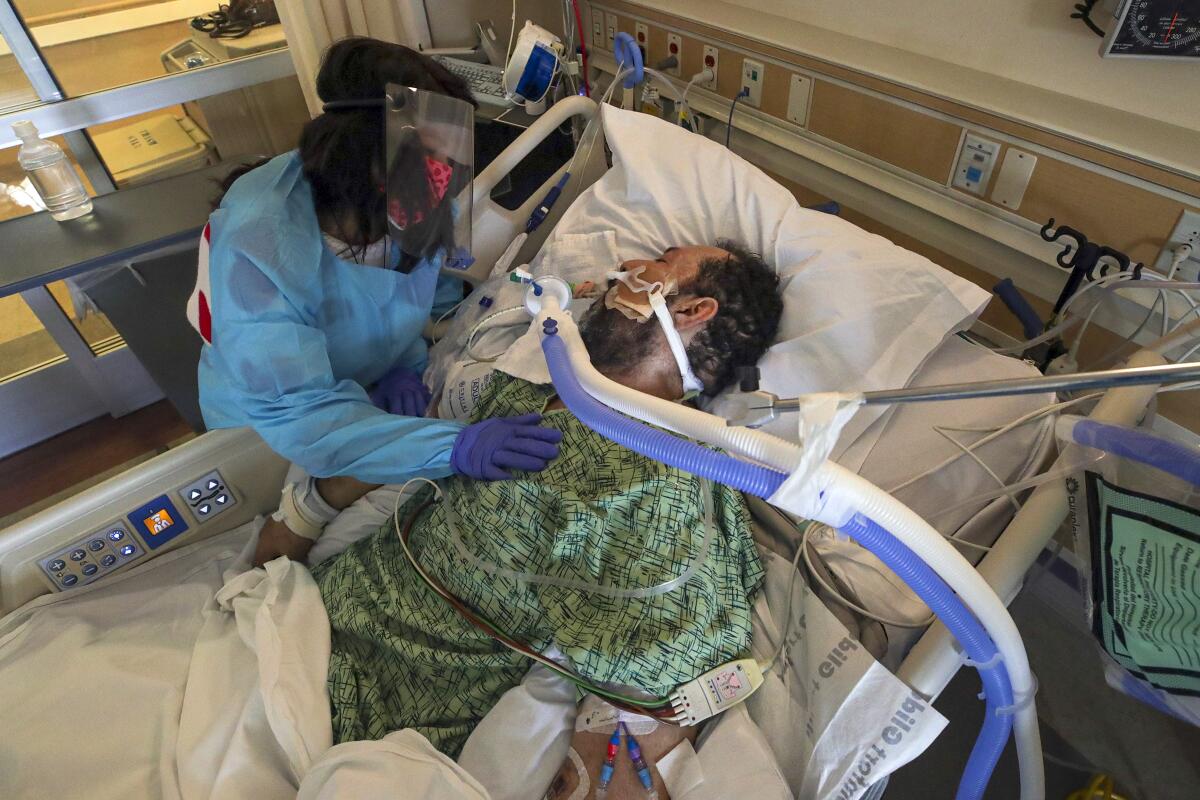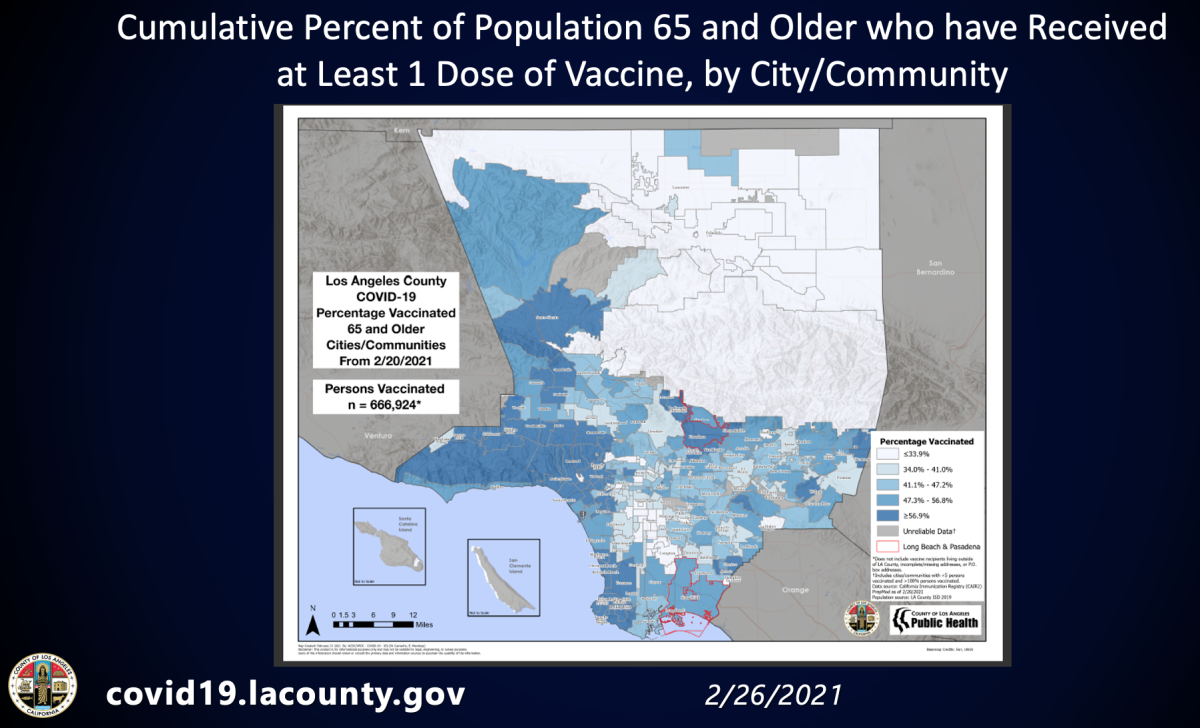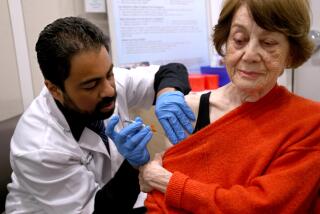New fears of next coronavirus wave as case declines slow and variants grow

- Share via
Federal officials are expressing worry that the decline in daily new coronavirus cases nationwide is starting to flatten as one of the variants, from the U.K., is on the rise.
They warned states against relaxing COVID-19 restrictions, saying the nation remains at a precarious point that could tip into a fourth surge before more people get vaccinated.
“We are at that very precarious position that we were right before the fall surge — where anything that could perturb that could give us another surge,” Dr. Anthony Fauci, President Biden’s chief medical advisor on the pandemic, told reporters at a briefing Friday. “We don’t want to be people always looking at the dark side of things, but you want to be realistic. So we have to carefully look at what happens over the next week or so with those numbers before you start making the understandable need to relax on certain restrictions.”
Andy Slavitt, senior advisor to the White House COVID-19 Response Team, said, “We couldn’t say it in stronger terms: We think it is a mistake to take our foot off the gas too early, especially when we are accelerating our vaccination efforts right now.”
Since early January, daily new coronavirus cases and COVID-19 hospitalizations have been dropping, but “the latest data suggests that these declines may be stalling, potentially leveling off at still a very high number,” said Dr. Rochelle Walensky, director of the U.S. Centers for Disease Control and Prevention. “We at CDC consider this a very concerning shift in the trajectory.”
The troubling numbers came a day before the U.S. Food and Drug Administration on Saturday issued emergency use authorization for a third COVID-19 vaccine, manufactured by Johnson & Johnson.
The nation had an average of about 66,350 new daily coronavirus cases a day over the last week, Walensky said Friday. That’s higher than the figure released Wednesday, which was 64,000 new cases a day.
The number of average daily COVID-19 deaths — about 2,000 a day — is slightly higher than it was a few days ago.
“We are watching these concerning data very closely to see where they will go over the next few days. But it’s important to remember where we are in the pandemic: Things are tenuous. Now is not the time to relax restrictions,” Walensky said. “Cases, hospital admissions and deaths all remain very high, and the recent shift in the pandemic must be taken extremely seriously.”
The recent increase in cases comes as federal officials have voiced alarm about the continued rise in variants nationwide. The increase in cases may be a result of the widening transmission of a variant first identified in Britain, B.1.1.7, that is believed to be 50% more transmissible than the conventional strain of the virus, Walensky said.
The U.K. variant now represents an estimated 10% of coronavirus cases nationwide, Walensky said, up from between 1% to 4% a few weeks ago. Walensky also expressed concern about an emerging variant in New York, B.1.526, and the California variant, B.1.427/B.1.429, which “also appear to spread more easily and are contributing to a large fraction of current infections in those areas, adding urgency to the situation.”
“The virus is not done with us. We cannot get comfortable or give into a false sense of security that the worst of the pandemic is behind us. Not now, not when mass vaccination is so very close,” Walensky said. “I know people are tired. They want to get back to life to normal, but we’re not there yet. Give us time. We need to get more vaccines into our communities and to get more people vaccinated.”
Walensky and other federal officials have repeatedly warned state and local governments against relaxing COVID-19 restrictions too quickly. Walensky has previously said it was too soon for states like Iowa and Montana to lift statewide mask-wearing orders. New York City began to permit indoor restaurant dining at 25% of capacity Feb. 12, and Massachusetts on Monday will lift its capacity limits on restaurants and allow indoor concert halls and theaters to reopen at 50% capacity, with no more than 500 people inside.
“Given the trends that we’ve seen in just the last couple of days, I would say we can’t be in a place where we’re lifting restrictions right now,” Walensky said.
In California, five counties — San Mateo and Marin counties, in the Bay Area; Yolo County, west of Sacramento; and Shasta and Humboldt counties farther north — were allowed by state officials to reopen indoor restaurant dining and indoor gyms to limited capacity this week. Seven counties may be eligible to do so next week: Santa Clara, San Francisco, San Luis Obispo, El Dorado, Napa, Lassen and Modoc.
One of the variants that concerns scientists the most is the strain first identified in South Africa, B.1.351, in which the effect of vaccination is significantly diminished but not obliterated. Fauci said that the pharmaceutical company Moderna this week began a clinical trial to test a booster shot specifically designed to be effective against the South Africa variant.
Another way to deal with other versions, such as the New York and California variants, Fauci said, might be to simply give a second booster shot of the existing vaccines, which would generate an even more robust immune response that would help deal with the problems created by the variants.
Fauci said the rise of the variants is all the more reason to get vaccinated with the currently available shots as quickly as possible when you’re eligible. Even among the more concerning variants, the vaccines still offer decent protection.
“Get vaccinated. The vaccine that’s available to you, get that vaccine. It is important to get as many people vaccinated as quickly and as expeditiously as possible,” Fauci said.
Officials in Los Angeles County have started to detect a slowing in the decline of daily coronavirus cases, said Dr. Paul Simon, chief science officer for the Department of Public Health.
L.A. County was averaging about 1,871 coronavirus cases a day over the last seven-day period, a 16% drop from the comparable figure a week earlier, which was 2,236 cases a day. That was a smaller decline than the previous week-over-week drop, in which average daily cases fell by 35%, according to a Times analysis.
A rate of 1,500 to 2,000 new coronavirus cases a day still “indicates a pretty significant level of ongoing community spread of the virus,” Simon said.
L.A. County on Monday will open up vaccinations to education and child-care workers, food and agricultural workers, and law enforcement and other emergency services workers who hadn’t been eligible earlier. Together, those groups comprise more than 1 million adults in L.A. County.
The county is expecting 269,000 doses to be distributed across vaccination sites in L.A. County next week, up from 211,000 doses that were distributed this week. Of the 269,000 doses, 103,000 will be set aside for first doses.
“Therefore it will take considerable time to vaccinate these groups, unless vaccine supply significantly increases,” Simon said. “We urge the public’s patience as we work through this process as swiftly as possible.”
People seeking vaccines in these sectors will need to supply proof that they live or work in L.A. County and proof that they work in an eligible sector and some kind of photo ID — it does not need to be government issued, officials said.
L.A. County officials released a new map Friday showing the disparities in vaccination rates by city and community among seniors 65 and older. Seniors living in South L.A., southeast L.A. County and the Antelope Valley had among the lowest vaccination rates, while the wealthiest areas had the highest inoculation rates.
For instance, Simon said, more than 70% of seniors in Beverly Hills, Manhattan Beach and Calabasas had received at least one dose of vaccine as of Feb. 20, while less than 35% of seniors in Compton, Cudahy, Lancaster and Palmdale had been vaccinated.

“We are implementing a number of measures to increase access to vaccination services among seniors and others in underserved communities,” Simon said.
California has administered 8.2 million doses of vaccines, Gov. Gavin Newsom said at a press briefing in Fresno on Friday, with the state averaging about 1.4 million doses a week. Soon, the goal will be to administer 2.7 million doses a week and eventually 4 million doses a week.
This week, California received 1.46 million doses; next week, 1.58 million doses are expected, and the week after that, 1.63 million doses, Newsom said. The governor offered an optimistic outlook for the coming weeks, considering how dire the situation in California was two months ago, when the state was ordering thousands of body bags. He also thanked Californians for adhering to rules to wear masks, practice physical distancing and cancel social gatherings.
Newsom on Friday sought to place more attention on state efforts to increase vaccinations in the Central Valley, including sending an additional 34,000 doses to inoculate food and agricultural workers. Low-income workers in the Central Valley have been hit particularly hard by the pandemic.
“Every day, we are doing better — a little bit better — on the issue of equity, and recognize we have a long way to go, so much more work to do to truly be held to account to a higher level of performance, particularly for our Latino community and our African American community,” Newsom said.
More to Read
Sign up for Essential California
The most important California stories and recommendations in your inbox every morning.
You may occasionally receive promotional content from the Los Angeles Times.











